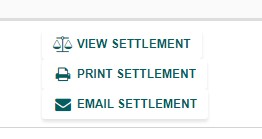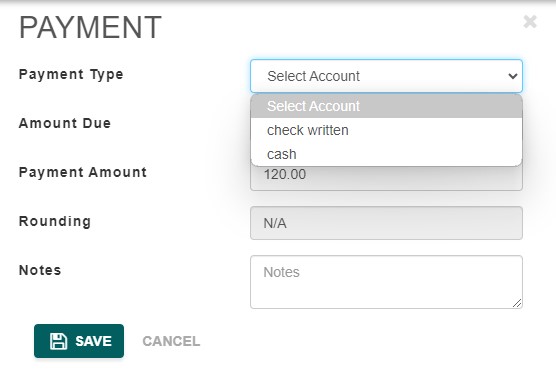View Seller Settlements
You can pay your sellers or consignors directly from the Settlement section in AF360.
If a seller is also a bidder, their settlements can be consolidated into a single, streamlined settlement for easier management.

Here’s an explanation of the settings shown in the Settlement Section of AF360:
- Deselect 0 Settlements: This button allows you to deselect any selected settlements. Since no settlements are currently selected, it shows “Deselect 0 Settlements.”
- Search Bar: The search bar lets you search for specific settlements by keywords such as bidder name, number, or other criteria.
- Total Settlements: This shows the total number of settlements. In this example, there is only 1 total settlement.
- Bidder#: Displays the bidder’s number if they are both a buyer and seller. In this case, no bidder number is assigned since this user is a seller.
- Name: The name of the seller (or bidder). Here, it’s listed as “House Seller.”
- Cash Buyer: A checkbox indicating whether the buyer (if applicable) is a cash buyer. In this case, it’s left unchecked since this individual is a seller.
- Lot Count: Shows the number of lots associated with this seller. In this example, the seller has 6 lots.
- Balance: The balance field shows the financial balance of the seller. A negative balance (in parentheses) indicates that the auction house owes the seller, in this case, ($120).
- Invoice Number/Status: Displays the invoice number or the status of the settlement. In this case, no specific status is shown.
- Shipping Requested: Indicates whether the seller has requested shipping. In this case, No shipping has been requested.
- View Settlement: Clicking this will allow you to view detailed information regarding this seller’s settlement, including payments, lots sold, and other relevant information.
- Print Settlement: This button enables you to print the settlement for record-keeping or to provide a physical copy to the seller.
- Email Settlement: Clicking this will allow you to send the settlement details directly to the seller via email.
These settings provide a quick overview and allow you to manage the settlement process efficiently, including viewing, printing, and emailing settlements for sellers.
Paying Your Sellers

Here’s an explanation of the Settlement Details screen for a seller in AF360:
- Customer Information:
- The customer (seller) is listed as SELLER – House Seller.
- The Customer Balance shows ($120.00), indicating that the auction house owes the seller $120 for the items sold. The negative amount in parentheses represents a payout to the seller.
- Lot #: This column displays the lot numbers of the items the seller consigned. In this case, Lot 1 and Lot 2 are shown.
- Status (Shipped / Picked Up): These checkboxes allow you to mark whether the items have been shipped or picked up by the buyer. Since they are unchecked, it suggests the items have not been marked as shipped or picked up yet.
- Title / Notes: This field shows the title or description of each item. In this case, the notes are labeled as “Test 1 (Seller)” and “Test 2 (Seller)” for the two lots.
- Qty Sold: This shows the quantity of items sold per lot. Both Lot 1 and Lot 2 show 1 item sold.
- Entries: This column provides a breakdown of the settlement, detailing the sale prices and commissions:
- For Lot 1, the item was sold for ($30.00). The commission rate applied is 40% Flat, resulting in a commission fee of $12.00.
- For Lot 2, the item was sold for ($20.00), with a 40% Flat commission, resulting in a commission fee of $8.00.
- The total balance owed to the seller, after the commissions are deducted, is shown as ($120.00).
- Delete Entry Button (Red X): The red X next to each entry allows you to remove a particular line item if necessary (e.g., to delete a sale or commission entry).
- Pay Customer (Button): Clicking this button initiates the process of paying the seller the balance they are owed. In this case, paying the seller the $120.00 they are due.
- Print Settlement (Button): This option allows you to print a detailed settlement report for the seller. This report includes all the lots, sale prices, commissions, and the final amount owed.
This screen provides a detailed breakdown of the seller’s items, how much they sold for, and the fees deducted, allowing you to manage and finalize the settlement for the seller.
- To pay a specific seller, click on ‘View Settlement’ located to the right of their name in the seller settlement section.

- Next, click on ‘Pay Customer’ in the top right corner to initiate the payment process.
Here’s an explanation of the Payment screen shown in the image:

- Payment Type (Dropdown Menu): This allows you to select the method of payment being used to pay the seller. The options available are:
- Check Written: This option indicates that the payment will be made by writing a check to the seller.
- Cash: This option is for paying the seller in cash.
- Amount Due: This field displays the total amount owed to the seller. In this case, the seller is owed $120.00.
- Payment Amount: This field allows you to manually enter the payment amount. By default, it’s set to the total amount due, $120.00, but you can adjust it if necessary (for partial payments or other adjustments).
- Rounding: This field is used for handling any rounding discrepancies in payment amounts, which may apply in certain cases. It is set to N/A (Not Applicable) by default unless there is a need to adjust for rounding.
- Notes: This field allows you to add any additional notes or details about the payment. For example, you could include the check number, payment details, or any other relevant information.
- Save (Button): Clicking this button saves the payment information and applies the payment to the seller’s account.
- Cancel (Button): This button cancels the payment entry process and closes the screen without saving any changes.
This screen is used to process payments to sellers, where you can select the payment type, enter the payment amount, and save the transaction for record-keeping.

